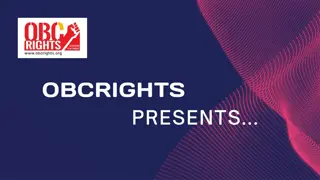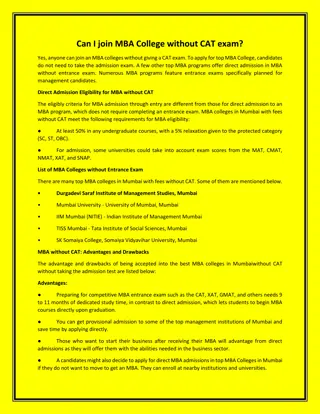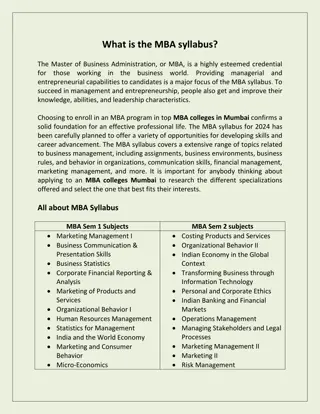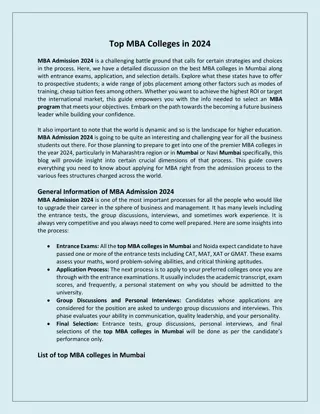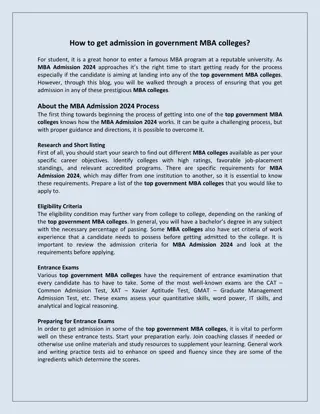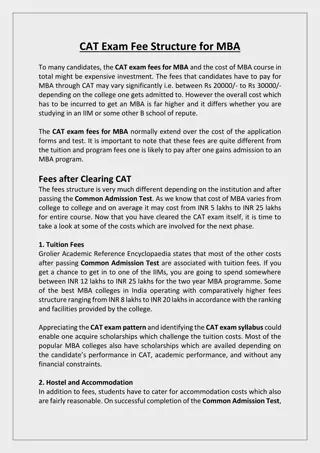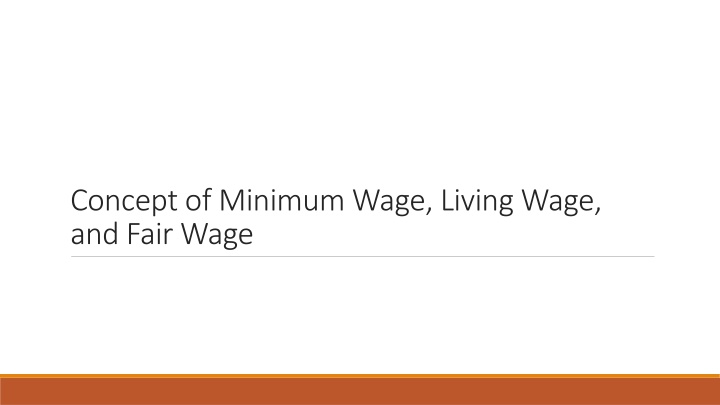
Wage Concepts: Minimum, Living, and Fair Wages Explained
Understand the concepts of minimum wage, living wage, and fair wage. Learn their definitions, purposes, key characteristics, pros and cons, and how they impact workers and economies globally.
Download Presentation

Please find below an Image/Link to download the presentation.
The content on the website is provided AS IS for your information and personal use only. It may not be sold, licensed, or shared on other websites without obtaining consent from the author. If you encounter any issues during the download, it is possible that the publisher has removed the file from their server.
You are allowed to download the files provided on this website for personal or commercial use, subject to the condition that they are used lawfully. All files are the property of their respective owners.
The content on the website is provided AS IS for your information and personal use only. It may not be sold, licensed, or shared on other websites without obtaining consent from the author.
E N D
Presentation Transcript
Concept of Minimum Wage, Living Wage, and Fair Wage
Overview Overview Wages are a fundamental aspect of labor economics and play a crucial role in determining the standard of living for workers. Governments, labor organizations, and businesses implement wage policies to balance fair worker compensation and economic sustainability. Three major wage concepts are widely discussed: Minimum Wage The lowest legally mandated wage an employer can pay an employee. Living Wage A wage that allows workers to afford basic necessities and maintain a decent quality of life. Fair Wage A wage that considers worker contribution, industry standards, and ethical compensation.
Minimum Wage Definition and Purpose Definition Minimum Wage is the legally mandated lowest amount an employer must pay an employee for work performed. It is typically set by government authorities and varies by country, industry, and sometimes region. Purpose To protect workers from exploitation and ensure they receive a basic level of income. To provide a baseline standard of living, though not necessarily sufficient for all essential needs. To reduce income inequality and promote economic stability.
Key Characteristics Fixed by law and government regulation. Adjusted periodically based on inflation and economic conditions. Different countries have different minimum wage policies some apply a national wage, while others vary by industry or state. Example of Minimum Wages in Different Countries United States: Federal minimum wage of $7.25 per hour, but states can set higher wages. United Kingdom: 11.44 per hour (as of April 2024) for workers aged 23 and over. India: Minimum wage varies by state and occupation, ranging from 176 to 500 per day.
Minimum Wage Pros and Cons Pros (Advantages) Protects low-income workers from exploitation. Helps reduce poverty and ensures a basic level of income. Boosts worker morale and productivity. Reduces reliance on social welfare programs. Cons (Disadvantages) Can lead to higher unemployment if businesses cannot afford to pay workers. May cause businesses to cut hours or reduce benefits to compensate for wage increases. Some minimum wages do not align with the cost of living, making them insufficient for workers. Encourages informal employment, where businesses may avoid regulations.
Living Wage Definition and Components Definition A Living Wage is a wage that enables workers to afford a decent standard of living, including essential expenses like: Housing Food Healthcare Education Transportation Unlike the minimum wage, which is legally enforced, the living wage is often a benchmark suggested by social and economic researchers.
Components of a Living Wage Components of a Living Wage Housing Food Costs Nutritious food and household groceries. Healthcare Costs Medical expenses, insurance, and emergency care. Transportation Costs Public or private transport expenses. Childcare and Education School fees, childcare, and tuition. Savings & Miscellaneous Emergency savings, leisure, and unforeseen expenses. Costs Rent or mortgage payments.
Living Wage Importance and Implications Importance Ensures workers can meet their basic needs and live with dignity. Reduces income inequality and improves economic stability. Enhances employee motivation and reduces turnover rates. Strengthens local economies by increasing purchasing power. Implications for Businesses & Government Companies that offer a living wage often experience higher employee retention and better job satisfaction. Governments may use tax incentives to encourage businesses to adopt living wage policies. Helps reduce the burden on social welfare programs by enabling workers to sustain themselves. Example of Living Wage Policies United Kingdom: The Real Living Wage ( 12.00 per hour outside London, 13.15 in London). Canada: Living wage varies by province, e.g., CAD 20 per hour in Vancouver.
Fair Wage Definition and Ethical Considerations A Fair Wage is a wage that is ethically justified and takes into account: Worker productivity and contribution. Industry wage standards. Employer profitability and ability to pay. Economic and social fairness. Fair Wage vs. Minimum & Living Wage A minimum wage is the lowest legal pay. A living wage ensures basic living costs are covered. A fair wage considers equity, fairness, and market conditions. Ethical Considerations Ensuring equal pay for equal work. Promoting worker dignity and recognition. Balancing employer financial capability with fair compensation.
Challenges and Future Directions Challenges Inflation & Wage Adjustments: Rising costs may make wages outdated. Employer Compliance: Some companies avoid wage policies to cut costs. Global Wage Disparities: Developing nations struggle with wage fairness. Future Directions Stronger Wage Policies: Governments and organizations should revise wages frequently. Corporate Responsibility: Businesses should promote fair and living wages. Technological Solutions: Data analytics can help determine fair wages based on industry trends






